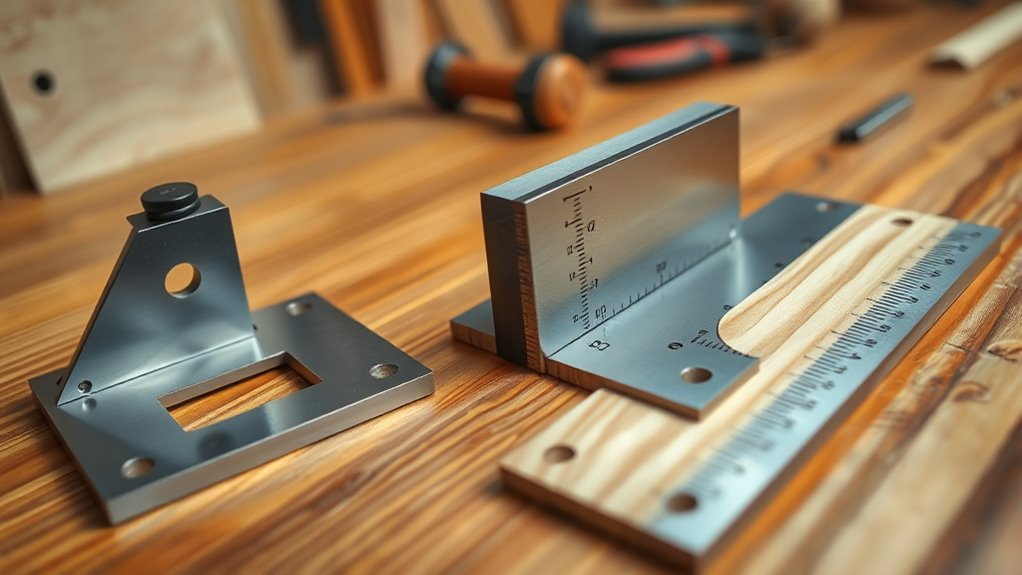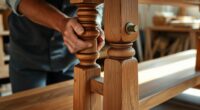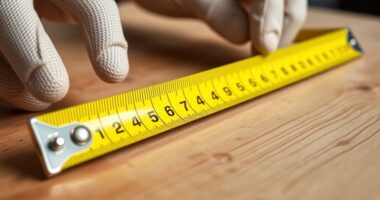Choosing the right squares for woodworking involves understanding try, speed, and combination squares. Try squares are perfect for checking right angles on large pieces, while speed squares offer quick measurements and angle markings for common degrees. Combination squares are versatile tools that measure, mark, and check angles accurately. Using these tools correctly guarantees precise cuts, tight joints, and professional results. Keep exploring to discover how to select, maintain, and use these essential tools effectively.
Key Takeaways
- Try squares are essential for checking and marking precise 90-degree angles on large woodworking pieces.
- Speed squares offer quick measurements and angle markings, ideal for framing and quick layout tasks.
- Combination squares are versatile tools used for measuring, marking, checking angles, and leveling in various woodworking projects.
- Using a mix of try, speed, and combination squares ensures accuracy and efficiency across different tasks.
- Regular maintenance and calibration of these squares improve measurement accuracy and tool longevity.

Have you ever wondered how to guarantee your woodworking projects come out perfectly straight and accurate? The key lies in choosing the right square and using it correctly. When it comes to measuring accuracy, the quality of your square plays a vital role. A high-quality square ensures precise measurements and perfect 90-degree angles, which are essential for tight joints and clean edges. But even the best tools need regular maintenance. Keep your squares free of dirt, rust, and damage, as these can compromise their accuracy. Check your squares frequently for signs of wear or warping, and calibrate or replace them when necessary. Proper tool maintenance guarantees that your measurements stay reliable over time, saving you from costly mistakes and rework. Additionally, understanding the affiliate relationships behind your tools can help you make more informed purchasing decisions. Different types of squares serve various purposes, but the combination of try squares, speed squares, and combination squares provides a versatile toolkit for any woodworker. Try squares, also known as framing squares, are perfect for marking and checking right angles on larger pieces. They’re fundamental when laying out cuts or ensuring your workpieces are aligned properly. Speed squares are compact and easy to handle, making them ideal for quick measurements and marking angles or cuts at common degrees. They’re especially useful for framing and roofing projects where speed and convenience matter. Combination squares are incredibly versatile—they can measure, mark, and check angles, and some come with a built-in level for added functionality. Using these different squares in tandem allows you to approach each task with precision, whether you’re cutting dovetails or verifying the squareness of a frame.
Speed, too, plays a role in woodworking, and selecting the right square can streamline your workflow. A well-designed speed square, for example, lets you quickly mark common angles without fuss, speeding up repetitive tasks. Meanwhile, a high-quality try square ensures your measurements are not only quick but also accurate, reducing the time spent correcting errors. Combining the use of these tools with consistent tool maintenance enhances your overall efficiency, giving you confidence in every cut and joint.
Ultimately, mastering the use of various squares and maintaining them properly leads to better craftsmanship. Your projects will turn out more precise, with tight joints and perfect edges. By focusing on measuring accuracy and keeping your tools in top shape, you’ll create work that’s not only functional but also a reflection of your skill. Investing in good squares and taking care of them pays off in the quality of your finished pieces, making each project more rewarding and professional-looking.
Frequently Asked Questions
What Is the Most Durable Material for Woodworking Squares?
You’ll find that stainless steel is the most durable material for woodworking squares. Its material comparison shows superior resistance to rust, corrosion, and wear, making it ideal for long-term use. Durability factors include strength, stability, and ease of maintenance. When choosing a square, opt for stainless steel to guarantee your tool withstands tough conditions, maintains accuracy, and lasts through many projects without losing precision or integrity.
How Do I Calibrate a Carpenter’s Square Accurately?
To calibrate a carpenter’s square accurately, start with calibration techniques like checking the blade against a known straight edge or a precision surface. Verify the accuracy by measuring 90 degrees at multiple points and adjusting if needed. Ascertain the square is clean and free of damage before calibration. Regularly verify its accuracy during use to maintain precision. Proper calibration guarantees your measurements stay reliable, making your woodworking projects more precise.
Can Digital Squares Improve Measurement Precision?
Digital squares can substantially improve your measurement precision by providing digital accuracy and measurement consistency. They eliminate guesswork, offer clear digital readouts, and reduce human error. With digital squares, you get precise angles and lengths every time, making your woodworking projects more accurate and professional-looking. You’ll find it easier to maintain consistency across multiple pieces, streamlining your workflow and boosting your craftsmanship.
What Are the Common Mistakes When Using a Square?
When using a square, you might make common measurement errors like misaligning the blade or not checking for warping. To avoid these, select the right square for your project, ensuring it’s accurate and sturdy. Always double-check your measurements and keep the square clean. Poor square selection can lead to inaccuracies, so invest in quality tools, and take your time aligning the square properly before marking or cutting.
How Do I Maintain and Store My Woodworking Squares?
A touch of elegance in your workspace can be achieved by properly maintaining and storing your squares. To keep them in prime condition, regularly check for rust or damage and wipe them down with a soft cloth. Store your squares in a dedicated, dry place, ideally hanging or in a sturdy drawer to prevent warping. Follow simple maintenance routines, like occasional lubrication, to ensure longevity and accuracy for your woodworking projects.
Conclusion
Now that you’ve explored different squares for woodworking, you’ve got everything you need to get started. Remember, choosing the right square can make all the difference, so don’t settle for less. Practice with speed and precision, and you’ll soon see your projects come together smoothly. Keep in mind, it’s not just about the tools you use but how you use them — so don’t let the cat out of the bag; master your squares and watch your skills soar.









